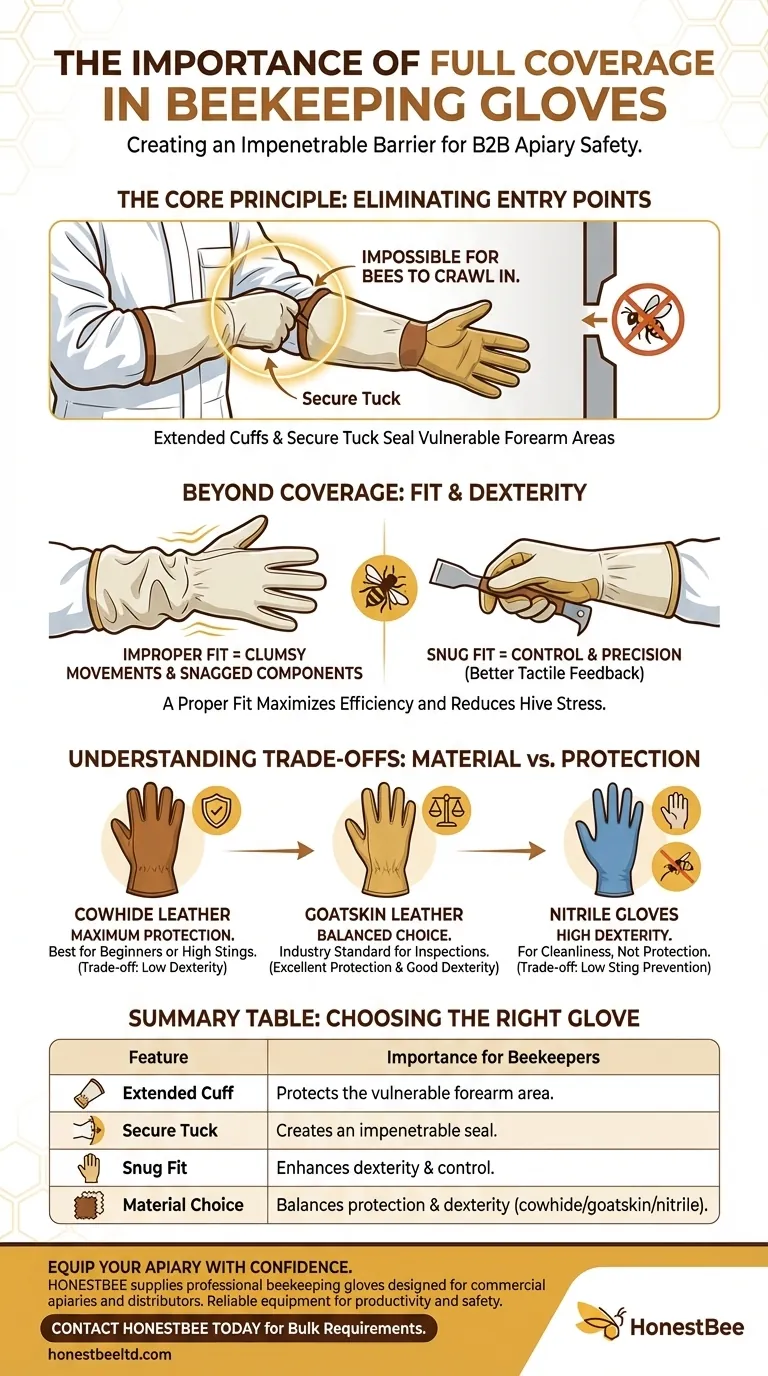The primary importance of full coverage in beekeeping gloves is to create a seamless, impenetrable barrier that eliminates any potential entry points for bees. Full coverage means the glove extends well past the wrist, allowing its long cuff to be securely tucked under your beekeeping suit or jacket, thus preventing stings on your hands and forearms.
The right beekeeping gloves aren't just about preventing stings; they're about creating a secure, confident extension of your hands. True protection comes from a combination of full coverage to eliminate gaps, a snug fit for dexterity, and the appropriate material for your task.

The Core Principle: Eliminating Entry Points
The fundamental goal of protective gear is to leave no part of your skin exposed. Bees are experts at finding small openings, and the junction between your glove and your sleeve is the most common point of failure.
Why Coverage Extends to the Forearm
A bee that lands on your hand will often crawl upwards. Gloves that only cover the wrist create a vulnerable gap where your sleeve might ride up, exposing your forearm.
Extended cuffs are a non-negotiable feature because they provide the necessary overlap to protect this high-risk area.
The Critical Tuck
The design of a long-cuffed glove is intentional: it's meant to be tucked securely inside the sleeve of your beekeeping suit.
This simple action creates an overlapping seal that makes it virtually impossible for a bee to crawl inside your glove or up your sleeve.
Beyond Coverage: Fit and Dexterity
While coverage is the first line of defense, a glove's effectiveness hinges on its fit. An improper fit can introduce new problems, even if the coverage is technically complete.
Fit Equals Control
A snug, but not tight, fit is crucial. Excess material from a loose glove can fold over, accidentally crush bees, or snag on delicate hive components like comb.
Well-fitting gloves give you better control and reduce the risk of agitating the colony through clumsy movements.
Dexterity and Precision
Beekeeping requires handling frames, tools, and sometimes the queen herself. Gloves that are too thick or bulky severely limit this tactile feedback, known as dexterity.
A proper fit maximizes your ability to work precisely and efficiently, reducing the time your hive is open and stressed.
Understanding the Trade-offs: Material vs. Protection
No single glove material is perfect for every beekeeper or every task. The choice always involves a trade-off between maximum protection and maximum dexterity.
Maximum Protection: Cowhide Leather
Cowhide provides the most robust protection against stings due to its thickness.
However, this thickness comes at the cost of dexterity, making it difficult to perform delicate tasks. It's often chosen by beginners who prioritize sting prevention above all else.
The Balanced Choice: Goatskin Leather
Goatskin is thinner and more supple than cowhide, offering an excellent balance between sting protection and functionality.
It remains the most popular choice for experienced beekeepers because it blocks stingers effectively while allowing for good dexterity when handling frames and tools.
High Dexterity: Nitrile Gloves
Thin nitrile gloves offer almost no sting prevention. A bee can easily sting through them.
Their benefit is keeping your hands clean from honey and propolis while offering the same dexterity as bare hands. They may reduce the chance of a stinger embedding, but they should not be considered primary sting protection.
How to Choose the Right Glove for Your Goal
Your choice depends on your comfort level, experience, and the specific task you are performing.
- If your primary focus is maximum sting prevention: Choose thick leather like cowhide, ensuring the long cuffs tuck securely into your suit.
- If your primary focus is a balance of protection and dexterity for hive inspections: Goatskin gloves are the industry standard, providing a great feel for frames without sacrificing safety.
- If your primary focus is high-dexterity tasks away from the main cluster of bees: Thin nitrile gloves can be an option, but you must accept the high risk of being stung.
Ultimately, the right gloves empower you to work calmly and confidently, ensuring the safety of both you and your bees.
Summary Table:
| Feature | Importance for Beekeepers |
|---|---|
| Extended Cuff | Protects the vulnerable forearm area by allowing a secure tuck into the suit sleeve. |
| Secure Tuck | Creates an impenetrable seal, preventing bees from crawling inside the glove or up the sleeve. |
| Snug Fit | Enhances dexterity and control, preventing accidental bee crushing and clumsy movements. |
| Material Choice | Balances protection (cowhide/goatskin) with dexterity (goatskin/nitrile) based on the task and experience level. |
Equip your apiary with confidence. HONESTBEE supplies professional beekeeping gloves designed for commercial apiaries and distributors.
We understand that your productivity and safety depend on reliable equipment. Our wholesale-focused operations provide durable goatskin and cowhide gloves that offer the perfect balance of full-coverage protection and the dexterity needed for efficient hive management.
Contact HONESTBEE today to discuss your bulk glove requirements and ensure your team is fully protected.
Visual Guide

Related Products
- Beekeeping Gloves Goatskin Leather with Long Cotton Sleeve for Beekeepers
- Goatskin Leather Beekeeper Gloves with Vent Long Sleeve for Beekeeping Honey Bee Sting Proof Protection
- Goat Skin Leather Bee Sting Proof Beekeeping Gloves with Canvas Sleeve
- Mesh Ventilated 3 Layer Goatskin Beekeepers Gloves for Beekeeping
- Professional Galvanized Hive Strap with Secure Locking Buckle for Beekeeping
People Also Ask
- Why is dexterity and flexibility important in beekeeping gloves? Boost Your Hive Management Efficiency
- What is the difference between cleaning cow leather and goat leather beekeeping gloves? Tailor Your Care for Longevity
- What is the safest way to handle frames in beekeeping? Master Gentle Handling for a Calm Hive
- Should beekeepers wear gloves, and why? Essential Protection for Beekeepers
- Why are protective gloves important in beekeeping? Boost Confidence & Safety in Your Apiary



















